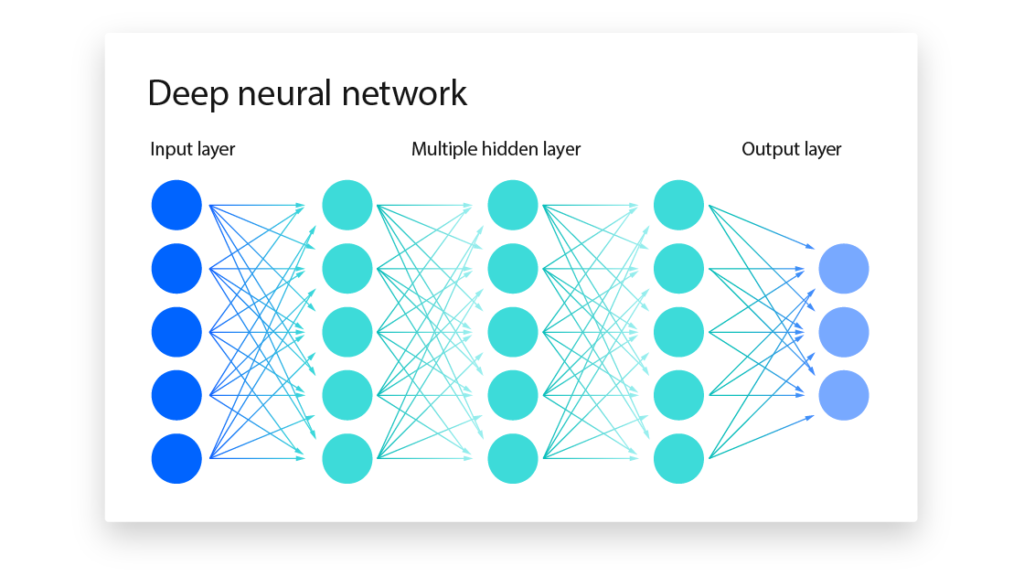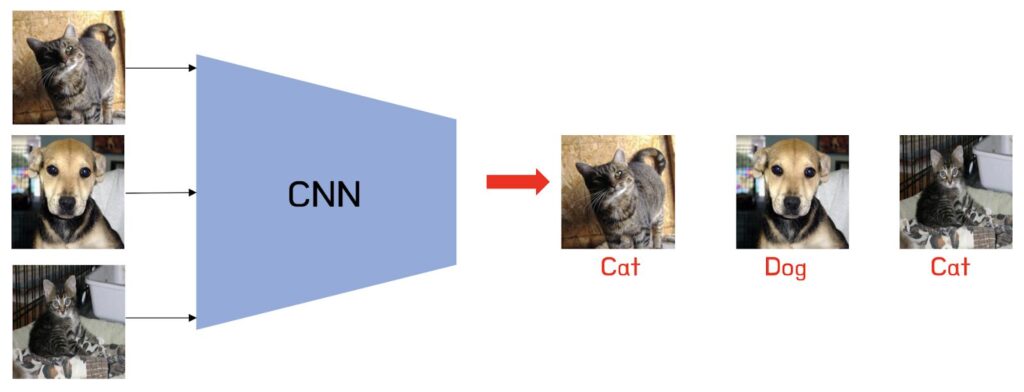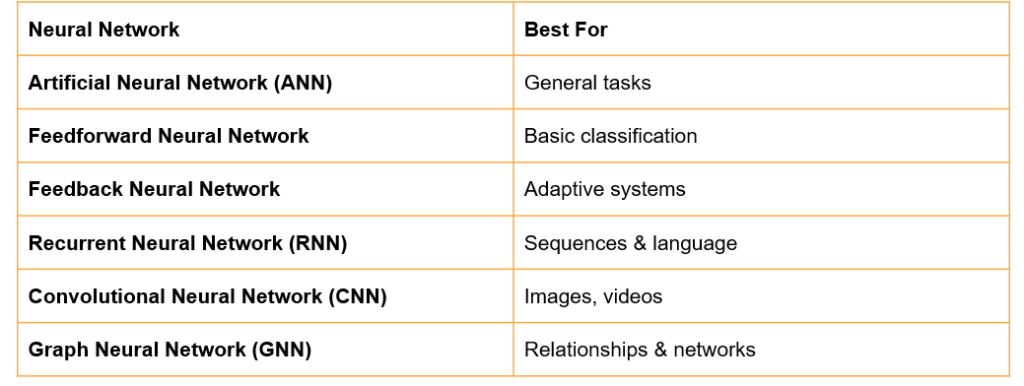From diagnosing diseases, powering self-driving cars, writing poems, and making stock predictions, neural networks are everywhere. But what exactly are they? How do they work? And why are they reshaping the future of technology as we know it?
Let’s explore the fantastic world of neural networks with WeCloudData. In this blog, you’ll learn how these artificial brains think and work, how they tie into data science and machine learning, and why they are the most exciting tech of our time. Let’s start!
What is a Neural Network?
A neural network mimics the human brain, functioning like a digital brain. Instead of neurons and synapses, it has layers, weights, and mathematical functions to replicate the workings of the human brain.
Neural networks are algorithms designed to recognize the relationships and patterns in the data, making judgments by simulating how biological neurons collaborate to identify phenomena, weight options, and reach a conclusion.
A neural network consists of interconnected nodes known as neurons, responsible for processing information just like the neurons in the human brain. Imagine teaching a baby to recognize an animal like an elephant. You show them some photos and videos, or bring them to the zoo; they start noticing patterns like head, ears, trunk, tusks, and tail. Neural networks work the same way. They’re a form of artificial intelligence (AI) that mimics how human brains learn by example.

Tidbit: The idea of neural networks dates back to the 1940s, before computers even had screens!
Inside a Neural Network: A Quick Breakdown
Every neural network has three main parts: the Input, hidden, and output layers. Here is a brief explanation of each layer, how it works, and what its functionality is.
- Input layer: The raw data passes to the next layer from the input layer. The data can be pixels from an image or numbers from a spreadsheet.
- Hidden layers: Experts refer to hidden layers as the thinking grid of neural networks. It’s where the thinking happens before a decision. In the hidden layer, neurons activate, connect, and adjust based on learning.
- Output layer: The output layer produces the final decision i.e, prediction or classification (like “cat” or “dog”).
- Weight: Each connection between neurons has a weight (importance level).
- Bias: Bias is a value added to the weighted sum, allowing flexibility in decision-making. Weight and bias play a key role in predictions.
- Activation Function: The Activation function decides whether a neuron should “fire” (like a brain signal). Common activation functions include ReLU, Sigmoid, and Tanh. It introduces non-linearity, allowing networks to learn complex patterns.
Tidbit: A “deep” network means it has many hidden layers. Hence, Deep Learning.

How do Neural Networks Work– Layer by Layer
Consider you are developing a system to classify between two animals in photos, i.e, cats and dogs.
1. Input Layer
The animal image (a 28×28 pixel grayscale photo) is converted into numbers (each pixel becomes a value). The pixels are passed to the input layer, each neuron here represents one feature (like the brightness of a pixel. Passing a raw image to the input layer is like showing an image to the computer.
2. Hidden Layers
Now the data is passed to the hidden layer, the neural network’s heart. In the hidden layer, every input neuron gets multiplied by a weight (a number showing the degree of importance of that feature).
Example: If the input neuron is “pointy ears = 1” and the assigned weight is “0.9,” then the input becomes 0.9, which remains powerful.
After assigning weights, the next step is to add bias(a small number) to the weighted sum. Bias helps shift the result, like adjusting the sensitivity of the neuron. Each neuron needs an activation function to decide “Should I pass this signal forward or not?” The activation function helps the network make smart, complex decisions, such as separating furry ears from floppy ones.
3. Output Layer
The neural network makes the decision and the result is passed on to the output layer, i.e.;
- 95% it’s a dog
- 5% it’s a cat
So, the final decision is: “This is a dog!”
In a nutshell, Neural networks:
- Take in image data
- Check for patterns
- Use weights, bias, and activation functions to make decisions.
- Output the best prediction (like “cat” or “dog”)
Like your brain saying, “Yeah, that’s definitely a dog,” the neural network prediction takes milliseconds.

Types of Neural Networks You Should Know
Researchers modify neural networks over time to complete specific tasks in multiple domains; here are the types of neural networks and their best use cases. Each of these neural networks is a specialized brain, like CNNs for sight, RNNs for memory, and GNNs for social IQ.
Feedforward vs. Feedback Neural Networks
The most basic type of neural network is a feedforward network, in which data only moves in one direction, from the input layer to the hidden layers and then to the output layer. Data doesn’t circle back once it flows forward, like a one-way street.
A feedback neural network or recurrent network creates loops in which the network’s output can be fed back into the input. It’s like the network is talking to itself, constantly refining its understanding based on previous outcomes. These neural networks form the basis of many intelligent systems in use today, ranging from chatbots and natural language models to self-driving cars and predictive analytics.
Recurrent Neural Networks (RNNs): The Memory Experts
Many tasks in the real world need to connect with previous actions or events. RRNs are used in systems where a task needs memory, like predicting the next word in a sentence or the next price in a stock chart. RNNs follow sequences; these neural networks remember previous input and, based on it, make a decision. RNNs uses range from;
- Text prediction & translation
- Time series forecasting
- Music & audio generation
Convolutional Neural Networks (CNNs): Masters of Vision
CNNs are capable of automatically identifying patterns in images, including edges, forms, and textures, because they are inspired by the way the human visual cortex works. People widely use them in everything from self-driving cars to medical imaging and facial filters on social media apps.
Graph Neural Networks (GNNs): Relationship Builders
Ever wonder on LinkedIn, you get notifications like “you might know Sam,” but how? That’s graph neural networks (GNNs) in action. GNNs analyze the relationships between data points rather than concentrating on individual data points. For this reason, graph neural networks are becoming increasingly popular in industries like banking and logistics that depend on networked systems.

The Role of Neural Networks in Modern Technology
Neural networks are the backbone of modern innovation; they make things possible that were once only sci-fi. Many applications that are common in our daily lives are backed by neural networks, including;
- Virtual assistants (Siri, Alexa)
- Self-driving cars
- Language models (ChatGPT, Gemini)
- Fraud Detection
- Facial Detection
- Recommendation systems
Learn, Build, and Lead with WeCloudData
At WeCloudData, we believe in making cutting-edge technology accessible and understandable. Whether you’re just getting started in data science or aiming to become a leader in AI and machine learning, our programs guide you through real-world projects and hands-on experience with tools like neural networks, CNNs, and more.
WeCloudData Offers:
- Comprehensive course in Python, SQL, statistics, AI, and Machine Learning.
- Expert-led courses on Power BI, Tableau, and Excel to enhance your data visualization skills.
- Hands-on projects to build practical experience.
- Mentorship from industry professionals to guide your learning journey.
- Consultation, providing you with AI solutions.
Ready to kickstart your career? Visit our website today and take the first step toward an exciting future in data and AI!

